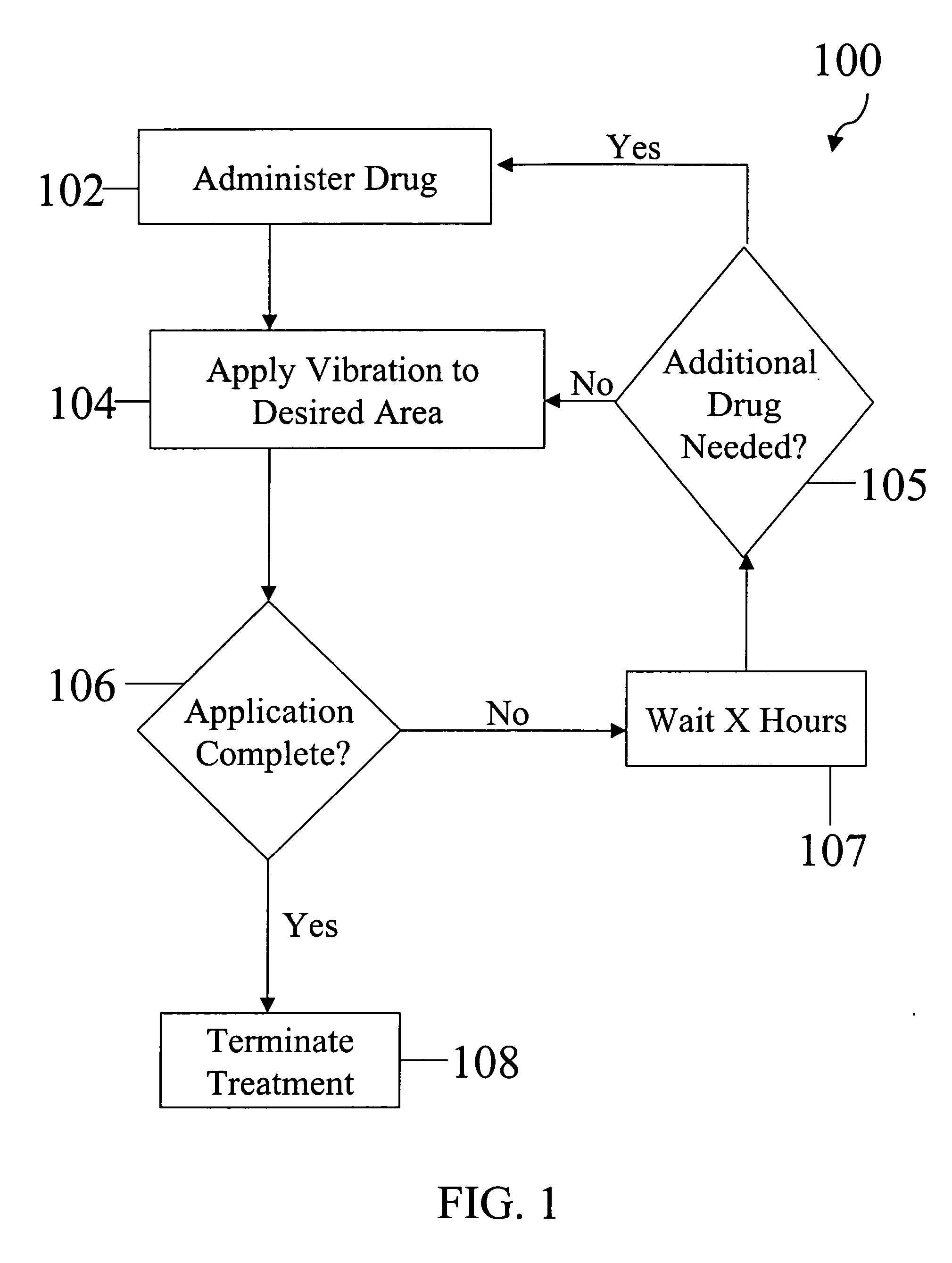Method of improved drug delivery and for treatment of cellulitis
a cellulitis and drug delivery technology, applied in the field of cellulitis improvement methods, can solve the problems of oedema stasis and heavy burden on hospital resources, and achieve the effects of reducing treatment time, stimulating tissue fluid turnover, and increasing microcirculation and blood flow
- Summary
- Abstract
- Description
- Claims
- Application Information
AI Technical Summary
Benefits of technology
Problems solved by technology
Method used
Image
Examples
example 1
[0040] Patient 1 (Female, 80 years old) [0041] Admission—Cellulitis [0042] History—Slight hypertension [0043] Cellulitis—right leg, with swelling / oedema
[0044] Treatment—intravenous antibiotics (Benzlpenicillin) for 48 hours, followed by oral antibiotics (Flucoxacillin) according to existing prescribed dosages
Day 1Day 7Calf Circumference34 cm32.5 cmThigh Circumference43 cm42.5 cm% of erythema / cellulitis reduction50% erythema & swellingstill present at day 12.[0045] Patient 2 (Male, 74 years old) [0046] Admission—Cellulitis [0047] History—Ischaemic heart disease [0048] Cellulitis—right leg, swelling
[0049] Treatment—intravenous antibiotics (Benzlpenicillin) for 48 hours, followed by oral antibiotics (Flucoxacillin) according to existing prescribed dosages plus Cycloidal Vibration 3× daily for 30 minutes
Day 1Day 4Calf Circumference43 cm41 cmThigh Circumference66 cm60 cm% of erythema / cellulitis reduction100%[0050] Summary: Patient 2 had 100% infection reduction by Day 4 plus signif...
example 2
[0051] Patient 3 (Female, 80 years old) [0052] Admission—Cellulitis, chest infection [0053] History—Ischaemic heart disease [0054] Cellulitis—left leg, with swelling / oedema
[0055] Treatment—intravenous antibiotics (Benzlpenicillin) for 48 hours, followed by oral antibiotics (Flucoxacillin) according to existing prescribed dosages
Day 1Day 7Calf Circumference35 cm33 cmThigh Circumference52 cm52 cm% of erythema / cellulitis reduction50% erythema & swellingstill present at day 9.
No swelling reduction after 7 days only 50% cellulitis reduction.
[0056] Patient 4 (Male, 74 years old) [0057] Admission—Hip replacement 2 months previously. Constant swelling led to cellulitis [0058] History—Stroke, angina, Ischaemic heart disease, hypertension [0059] Cellulitis—left leg, swelling and blistering
[0060] Treatment—oral antibiotics (Fluloxacillin) plus Cycloidal Vibration 3× daily for 30 minutes
Day 1Day 6Calf Circumference37 cm32 cmThigh Circumference45 cm40 cm% of erythema / cellulitis reduction1...
example 3
[0062] Patient 5 (Male, 70 years old) [0063] Admission—Chest infection [0064] History—Anaemia (not long standing, now resolved) [0065] Cellulitis—left leg, swelling / oedema
[0066] Treatment—IV antibiotics for 48 hours, then oral antibiotics
Day 1Day 7Calf Circumference31 cm29.5 cmThigh Circumference41 cm 42 cm% of erythema / cellulitis reduction75% plus little oedemareduction[0067] Patient 6 (Female, 88 years old) [0068] Admission—Cellulitis [0069] History—Ischaemic heart disease, hypertension [0070] Cellulitis—severe right leg, swelling
[0071] Treatment—oral antibiotics (Metronidazole) plus Cycloidal Vibration 3× daily for 30 minutes
Day 1Day 7Calf Circumference35 m32 cmThigh Circumference45 cm38.5% of erythema / cellulitis reduction75%, plus significantoedema reduction[0072] Summary: Patient 5 was treated with both intravenous and oral antibiotics and had 75% reduction in 7 days. Patient 6 had severe cellulitis and was treated only with oral antibiotics plus cycloid vibration treatm...
PUM
| Property | Measurement | Unit |
|---|---|---|
| Length | aaaaa | aaaaa |
| Length | aaaaa | aaaaa |
| Time | aaaaa | aaaaa |
Abstract
Description
Claims
Application Information
 Login to View More
Login to View More - R&D
- Intellectual Property
- Life Sciences
- Materials
- Tech Scout
- Unparalleled Data Quality
- Higher Quality Content
- 60% Fewer Hallucinations
Browse by: Latest US Patents, China's latest patents, Technical Efficacy Thesaurus, Application Domain, Technology Topic, Popular Technical Reports.
© 2025 PatSnap. All rights reserved.Legal|Privacy policy|Modern Slavery Act Transparency Statement|Sitemap|About US| Contact US: help@patsnap.com


